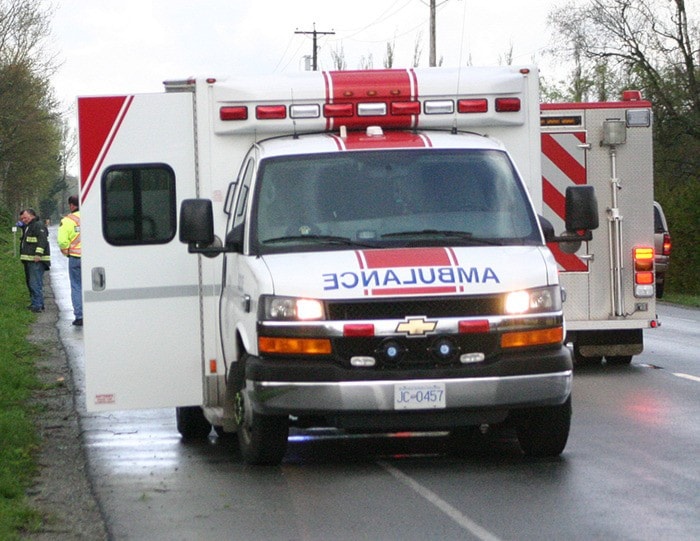There have been at least two residents who have died while waiting for an ambulance in Mission, says Mayor Randy Hawes.
According to Hawes, the most recent incident happened about two months ago. Because of confidentiality issues, he did not elaborate on the situation, but said the spouse of the victim questions whether her husband would be alive today if she brought him to the hospital herself rather than wait more than 30 minutes for an ambulance.
Hawes made the comment at a meeting last week to discuss ambulatory services in the community with representatives from BC Emergency Health Services (BCEHS) executives and the Ambulance Paramedics of B.C. (APBC) union.
BCEHS executive vice-president Linda Lupini and Dr. William Dick, vice-president of medical programs for BCEHS were both surprised to hear about the deaths.
“Not a single person should die waiting for paramedic service. It’s not okay,” said Lupini. “We did a lot of digging (on Mission cases) this past weekend and there was not a single piece of information on patient death related to the way we respond now.”
“If there are cases you have heard of here with untoward outcome, I want to know about it,” added Dick, who investigates cases when people believe someone has died as a result of a delay. “I am shocked to hear of a death.”
Dick said each call is ranked, just like in the emergency department of a hospital, and the most urgent cases are responded to first.
Changes were made to the province’s Resource Allocation Plan in 2013 to try to provide faster response to patients with critical injuries.
A study is currently being conducted to determine the needs of Mission and other communities in the province.
The new leadership team put in place last year say there wasn’t a lot of evidence-based decision-making, noted Lupini, noting good data is needed to help get more funding for the service.
“If you need another crew because we’re not making those cases, we’ll fix it,” said Lupini.
The report is expected to be completed this summer.
After the meeting, Mission Fire Chief Larry Watkinson provided details of the two incidents for the executives to follow up on. He said he filed the paperwork through the appropriate channels, but will now forward his concerns and inquiries to BCEHS and BC Ambulance Service (BCAS) management.
Firefighters are trained first responders and in addition to fighting fires, Mission’s fire/rescue department also has an agreement in place to respond to medical emergencies.
“These skills prepare them for carrying out critical life-saving duties as a first responder,” said Watkinson. “Transportation is solely the responsibility of the BC Ambulance Service, as outlined by our agreement with BCAS/BCEHS.”
According to a report to council from Watkinson, 35 per cent of the calls his department responded to in 2014 to were medical ones, and with the changes to how BCAS responds to calls, firefighters are often on scene first.
The fire department’s resources are tied up when BCAS is delayed, states the report.
“There is no doubt that the community of Mission has been on the receiving end of a dysfunctional system rather than an incapable operation,” said Watkinson.
“There is a growing concern from our first responders that coding of medical calls as low acuity instead of life-threatening emergencies is becoming more common, thus putting our first responders on scene with patients with deteriorating conditions.”
In 2014, someone waited 120 minutes for BCAS after sustaining a fall/back injury; and in another case, someone suffering from convulsion/seizure waited 57 minutes. Other examples provided included a 26-minute delay for a call about a breathing problem, a 37-minute delay for a laceration, and a 15-minute delay for a cardiac arrest.
APBC union representative Pete Smith agreed better response times are needed.
He told Mission council B.C. is 22 ambulance units below the national standard.
“It’s what frustrates paramedics,” he said. “There’s no shortage of staff … It’s not about staffing, it’s about resources on the ground.”
Mission has a full-time ambulance unit, and one paid on-call. According to Smith, the full-time unit is often out of the community. As a provincial operation, ambulances have no boundaries and can be in any community, regardless of where the home station is. The paid on-call unit is down 35 per cent of the time.
Two years ago Smith had to call an ambulance because his infant son was in respiratory arrest at home. But Smith, who works as a paramedic in Abbotsford, knew he would face a lengthy wait time and chose to drive his baby to the hospital on his own.
After the meeting, Smith said he wasn’t surprised to hear about the two deaths Mission council mentioned.
Last month his unit was called to Mission to respond to a man with cardiac arrest. Mission’s ambulance was out of the community and his unit was the closest one. It took him 13 minutes to get to the patient and it was too late.
“When it comes to cardiac arrest, time is everything,” said Smith, noting the brain starts deteriorating after six minutes.
“Early treatment is the key,” said Smith. “The suffering is what gets to me, too.”
Smith believes another study is not needed. “The numbers have been there for years … More resources are needed.”
